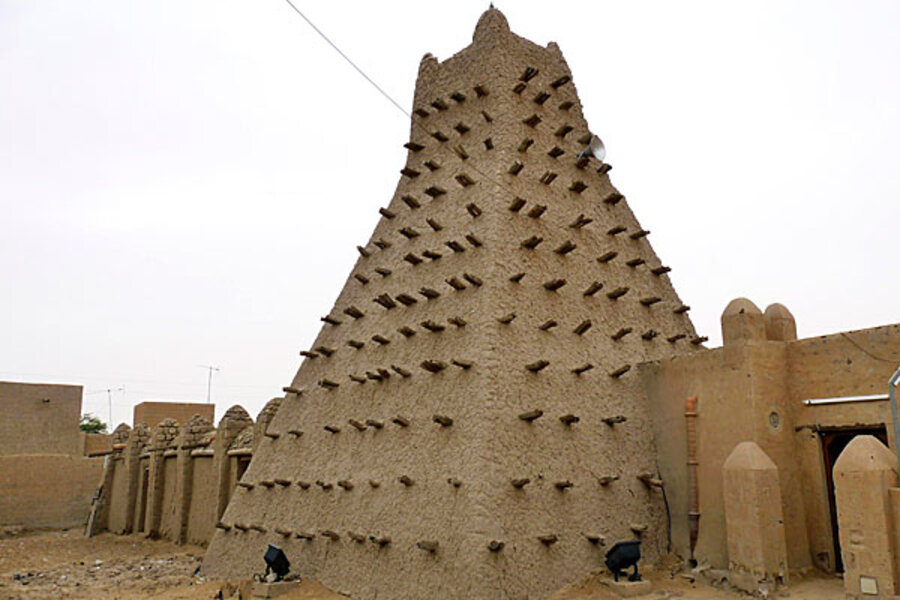Islamists destroy Timbuktu heritage sites: Why are these targets?
Loading...
When Islamist militants began this week to destroy ancient tombs of some of Mali’s most famous poets and Sufic teachers, they claimed that they were doing the work of God.
“We’re going to destroy everything before we apply Shariah in this city,” Ansar Dine spokesman Sanda Abu Mohamed told the Associated Press on Sunday in the ancient city of Timbuktu.
According to Ansar Dine – a relatively small militant group that shares control of much of northern Mali with other rebel groups and shares the theological outlook of Al Qaeda – the tombs had to be destroyed because “the population loves the saints like God.”
Today’s Ansar Dine, of course, is just the latest in a long line of religious dogmatists who came to town and destroyed stuff in the name of God.
In 1192 AD, the Turkic commander Qutbuddin Aynak destroyed a number of Hindu temples near present day New Delhi to provide building stone for his self-named Qutb Minar. To this day, Hindu nationalists point to this act as an example of Islam's intolerance of other faiths. Yet some scholars, notably Buddhists, contend that Hindus had done similar work with the defunct temples of their Buddhist rivals.
Roman historians documented how Christian rulers ordered the destruction of pagan temples, and reportedly, the Library of Alexandria itself in 391 AD. During the Spanish Reconquista, Roman Catholic rulers razed many Islamic prayer halls, although, to their credit, they did leave many magnificent Moorish structures, such as the university at Alhambra, standing.
More recently, of course, the Taliban leader Mullah Muhammad Omar ordered the destruction of the Buddhist statues in the Afghan central province of Bamiyan in March 2001. “All we are breaking are stones," the Taliban leader told reporters in Kandahar at the time, adding, "my job is the implementation of Islamic order."
Each of these perpetrators of destruction, though belonging to different faiths, saw themselves as defenders of their faith, reformers of society, and enemies of superstition. While some of these so-called reformers may have halted the religious practice of others – as Ansar Dine has halted the reverence of Sufi teachers and saints in Timbuktu this week – in other cases, the destruction of religious monuments is largely a symbolic and political act. There were no local adherents of Buddhism in Bamiyan, when the Taliban artillery pieces used Buddha’s stone face for target practice. But their action had political power: It signaled to the world, and to the Islamic faithful, that the Taliban’s control of Afghanistan was total. There might be rivals, such as the Northern Alliance of Ahmed Shah Masood, tucked away up in the Panjshir Valley, but there was very little they could do to stop the Taliban from doing what it wanted to do.
Mali’s government, which lost control of northern Mali after its own Army launched a coup in March to topple the civilian government, has condemned the Ansar Dine destruction of shrines as a “war crime.” But with Mali’s politicians primarily focused on finding their place in the current political structure, and with Mali’s Army focused primarily on maintaining its own tenuous control of the political process, there is precious little they can do to stop the Ansar Dine from doing what they want to do up in Timbuktu.
Now, the question will be what will Ansar Dine do with all those private libraries and ancient books from the days when Timbuktu was a famous center of Islamic learning.? Will they revere these books as examples of Islam’s proud history? Or will they see all of those books as threats to the pure true faith taught by the prophet Muhammad in the Quran.
If they do the latter, then we can expect Malians to start smuggling out ancient manuscripts from Timbuktu, just as Afghans smuggled out ancient Buddhist artifacts from Afghanistan during Taliban rule.





